How to use a cordless drill
Cordless drills are without doubt amongst the most useful tools that any DIY enthusiast will own, and therefore it is essential to know how to use a cordless drill correctly. Before I begin, forget all the hundreds of different terms you’ve read or seen describing this type of tool as there really are only three main categories of cordless drill. Firstly there’s a cordless drill driver, secondly there’s a cordless combi drill, and thirdly there’s a cordless SDS drill. Forget the SDS drill for this guide, as it’s a more heavy duty option.Therefore below, I’m only concerned with the two most commonly used types of cordless drill – the drill driver and the combi drill driver – both of which operate in nearly exactly the same way.
New cordless drills
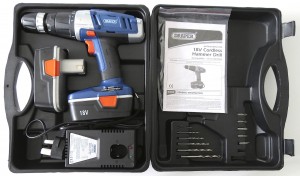
Drill body, two batteries, charger, all in a carry case – the ideal cordless drill ‘package’.
When you buy a cordless drill, you will generally be supplied with the drill body, at least one battery and a battery charger. Ideally it will be supplied in a carry case for easy storage, which may also include a few spare drill bits and screwdriver bits.
In my guide ‘Buying a cordless drill’, there’s a lot more detail on choosing the right model, but always remember, before you make a purchase, to check exactly what you’re getting ‘in the box’.
The model shown here comes with two batteries and a charger, which is ideal, but sometimes what may appear to be a cheap drill bargain, is not the case at all, as you may only be purchasing the drill body, with no batteries, and no charger.
Charging drill batteries
The first thing you need to do with a new drill is charge the batteries. It’s always important to give the batteries a full charge before first time use, and make sure you read your instruction booklet as different manufacturers can make slightly differing recommendations on initial battery charging.
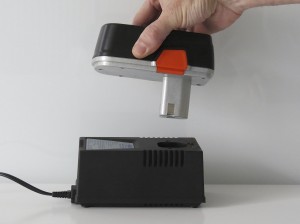 |
1. To charge batteries you simply plug in the charger and push the thin end of the battery pack into the top of the charger – be aware that there will be a right way round, for this operation. |
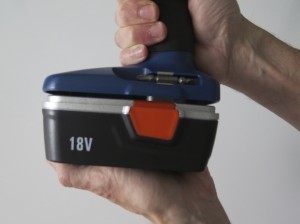 |
2. Once charged, insert the battery into the drill body by aligning the thin end of the battery pack with the hole in the drill handle body, and push it into place. |
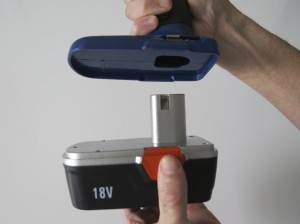 |
3. When you need to change a battery, simply press on the releasing clips on each side of the battery pack, and the battery will drop down away from the drill body. |
Cordless drill features
Cordless drills have a few standard features and functions. The following section explains a little more about these functions, specifically, drill mode, torque, gears, and the all important trigger.
Drill mode and torque
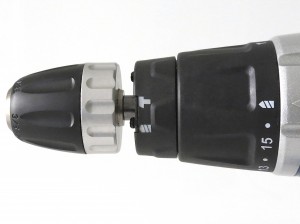
The business end of the drill which has the chuck, drill mode selector and torque selector.
Down the business end of the cordless drill, you’ll find the chuck (where drill and screwdriver bits are inserted), which with the vast majority of models, is what’s referred to as a keyless chuck, as it is simply tightened by hand to secure bits in place (see further down).
You’ll also find a revolving collar to select the torque, as well as the drill mode. This is where you see the difference between a drill driver and a combi drill driver. A combi drill driver basically has the added feature of being able to drill into masonry, because it has a hammering action, denoted by the little hammer motif you can see with this drill. Plain drill drivers simply won’t have the hammer motif.
The advantage of a combi drill is that the hammer action basically means you can drill into masonry – with simple cordless drill drivers, you just can’t drill a hole in hard masonry surfaces.
Gear/speed selector
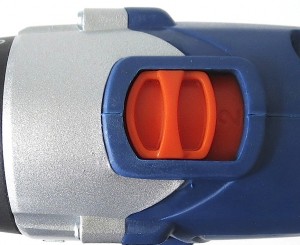
To change gear you simply flip the gear switch. Only change gear when the drill has stopped running.
As well as the mode and torque selectors, on the top of the drill you’ll also find the gear selector. Some drills will only have one gear, most have two, and top end cordless drills will have three. Basically gear one is slower speed but will provide more power, and as you go up the gears, you get more speed but less power.
For drilling, you tend to use the high gear, as well as for most screwdriving requirements, but when you need more power to drive a long screw into position, for example, you drop down to gear one, and adjust the torque collar to a higher number.
With both the torque collar and gear selector, a little experimentation with your particular drill, will help you find the best settings for different jobs.
Drill trigger
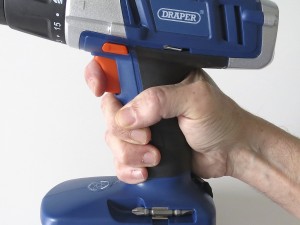
Cordless drill triggers are simple to operate, and give you another way of controlling the speed at which the drill bits rotate.
The drill is operated by pressing the trigger. With most drills you will also be able to control speed by the amount of pressure you use on the trigger. In fact you generally find that it’s not very often that you’ll be applying full pressure on the trigger, especially when using your cordless drill for driving in screws.
Above the trigger you’ll find another switch which is a forward or reverse option. Most of the time you’ll be using the forward mode, to drill holes, or drive in screws, but having a reverse mode is clearly essential for removing screws when the need arises.
Drill bits and screwdriver bits
Cordless drills need bits, and they need to be inserted into the cordless drill in the correct way. The bits are simply inserted into the keyless chuck as shown below. No tools are required, it’s simply a case of tightening, or loosening, by hand.
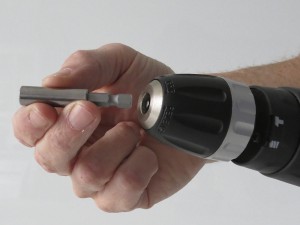 |
1. For using your drill as a screwdriver, you need to insert screwdriver bits. Best practice, is to first insert a screwdriver bit holder into the chuck. Simply make sure that you have undone the chuck sufficiently to fit the end of the bit holder in place. |
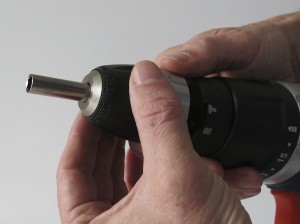 |
2. Secure the bit holder in place by tightening the chuck. You’ll see an arrow on the side of the chuck to show which way you rotate to tighten, and which way you rotate to loosen off. |
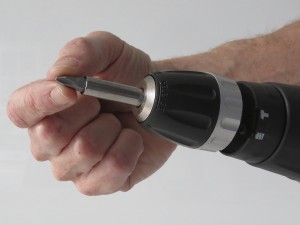 |
3. You now pop the screwdriver bit into the end of the bit holder. Bit holders like the one shown are normally magnetic, so the bit is held fairly securely in place. For more information on screwdriver bit holders, see my guide – ‘Screwdriver bits’. |
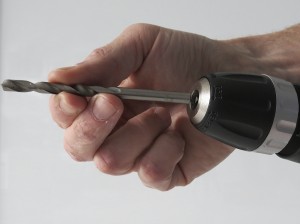 |
4. For drill bits, you don’t need any type of holder, the bit simply slots into the chuck and you hand tighten the chuck to hold it in place. |
For further information on using a cordless drill, there’s plenty of further advice in my guides – ‘Fixing into masonry walls’ and ‘Fixing into hollow walls’.
Finally, different cordless drills will have slight design variations and so the above guide is pointing out the general principles of how to use a cordless drill. Therefore always read your manufacturer’s guidelines to ensure you know exactly how to use your particular make and model of drill, before you begin work.Â
